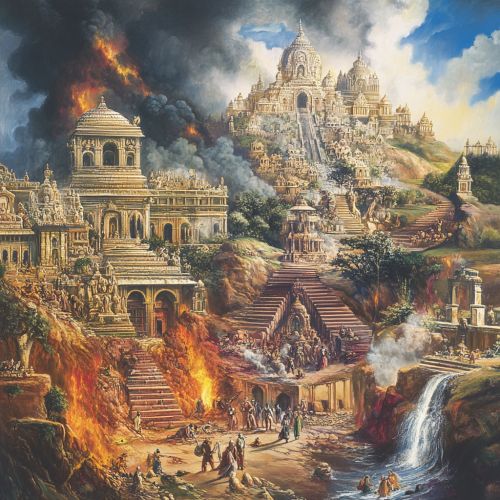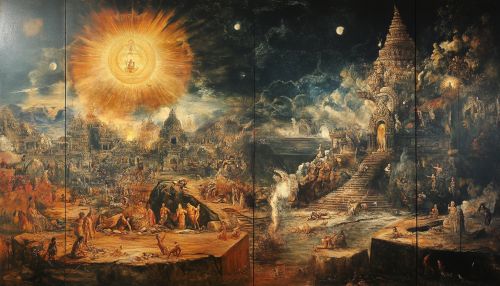Kali Yuga
Introduction
Kali Yuga, often referred to as the "age of darkness" or "age of vice," is the fourth and final stage in the cycle of yugas described in Hindu scriptures. According to Hindu cosmology, the world undergoes a continuous cycle of four yugas or epochs: Satya Yuga, Treta Yuga, Dvapara Yuga, and Kali Yuga. Each yuga is characterized by a gradual decline in righteousness (dharma) and an increase in sin (adharma). Kali Yuga is considered the most degenerate of the four ages, marked by moral decay, spiritual degradation, and societal collapse.
Etymology and Definition
The term "Kali Yuga" is derived from Sanskrit, where "Kali" signifies strife, discord, quarrel, or contention, and "Yuga" means age or epoch. The word "Kali" in this context is not to be confused with the goddess Kali, who represents time and change. Instead, it refers to the demon Kali, who symbolizes the negative qualities prevalent in this age.
Duration and Timeline
According to the Puranas, particularly the Vishnu Purana and Bhagavata Purana, Kali Yuga lasts for 432,000 years. It is believed to have begun at midnight on 18 February 3102 BCE, following the departure of Lord Krishna from Earth. This timeline is based on traditional Hindu astronomical calculations and is corroborated by various ancient texts.
Characteristics of Kali Yuga
Kali Yuga is characterized by a significant decline in moral and ethical standards. The Mahabharata and Bhagavata Purana provide detailed descriptions of the symptoms and signs of this age:
- **Moral Decay**: Truthfulness, compassion, and righteousness diminish. People become deceitful, selfish, and materialistic.
- **Spiritual Decline**: Religious practices lose their sanctity, and people engage in superficial rituals without understanding their deeper significance.
- **Social Disorder**: Society becomes fragmented, with increased strife, conflict, and lawlessness. Traditional social structures and values disintegrate.
- **Environmental Degradation**: Natural resources are exploited unsustainably, leading to environmental crises.
- **Shortened Lifespans**: Human lifespans and physical strength decrease significantly compared to previous yugas.
Scriptural References
Kali Yuga is extensively discussed in various Hindu scriptures, including the Vedas, Puranas, and Itihasas.
Vedas
The Atharva Veda mentions the characteristics of Kali Yuga, highlighting the decline in dharma and the rise of adharma.
Puranas
The Vishnu Purana and Bhagavata Purana provide detailed descriptions of the symptoms of Kali Yuga and the timeline of the yuga cycle.
Itihasas
The Mahabharata and Ramayana also reference the characteristics and challenges of Kali Yuga, often contrasting it with the virtues of earlier yugas.
Societal Impact
The societal impact of Kali Yuga is profound, affecting various aspects of life:
- **Religion**: Religious institutions become corrupt, and genuine spiritual seekers are rare.
- **Politics**: Governance becomes characterized by tyranny, corruption, and incompetence.
- **Economy**: Economic inequality widens, with wealth concentrated in the hands of a few.
- **Family Structure**: Traditional family values erode, leading to increased divorce rates and broken families.
- **Education**: The quality of education declines, with a focus on material success rather than holistic development.
Remedies and Practices
Despite the challenges of Kali Yuga, Hindu scriptures offer remedies and practices to mitigate its negative effects:
- **Bhakti Yoga**: Devotional practices, particularly the chanting of the Hare Krishna mantra, are emphasized as effective means of spiritual upliftment.
- **Satsang**: Associating with saintly persons and engaging in spiritual discourse helps maintain dharma.
- **Charity**: Acts of charity and selfless service are encouraged to counteract selfishness and materialism.
- **Meditation and Yoga**: Regular practice of meditation and yoga helps maintain mental and physical well-being.
Eschatology and End of Kali Yuga
Hindu eschatology predicts the eventual end of Kali Yuga, followed by the advent of a new Satya Yuga. This transition is often associated with the arrival of Kalki, the tenth and final avatar of Vishnu, who is prophesied to restore dharma and initiate a new golden age.
Cultural Representations
Kali Yuga has been a subject of interest in various cultural and literary works. It is often depicted in Indian epics, folktales, and modern literature as a time of great turmoil and transformation.
Conclusion
Kali Yuga, as described in Hindu cosmology, represents a period of significant moral and spiritual decline. However, it also offers opportunities for spiritual growth and transformation through dedicated practice and adherence to dharma. Understanding the characteristics and challenges of Kali Yuga can provide valuable insights into the human condition and the cyclical nature of time.


